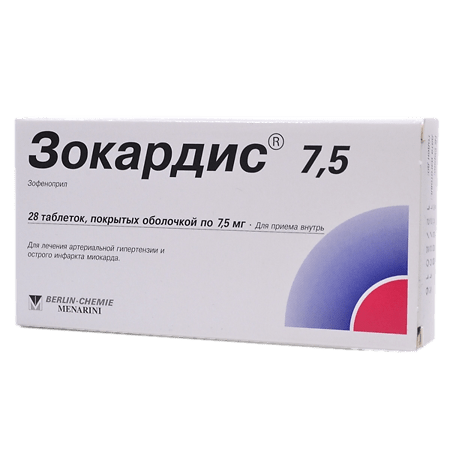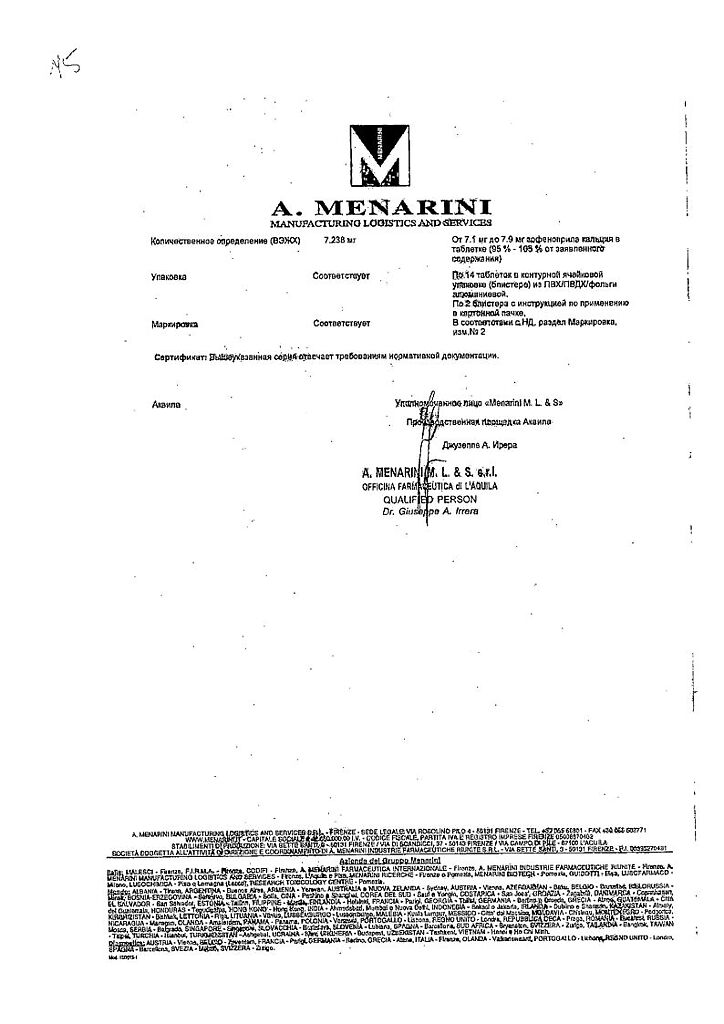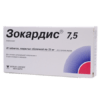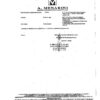No products in the cart.
Zocardis 7,5, 7,5 mg 28 pcs
€13.30 €11.09
Description
Pharmacodynamics
A ACE inhibitor, antihypertensive drug. The mechanism of action is associated with a decrease in the formation of angiotensin II from angiotensin I. Reduction of angiotensin II leads to a direct reduction of aldosterone release, with decreased RPS, systolic and diastolic BP, post- and preload on the myocardium. Dilates arteries more than veins, and there is no reflex increase in heart rate. Reduces bradykinin degradation, increases prostaglandin synthesis.
Hypotensive effect is more pronounced at high blood plasma renin concentration than at normal or reduced concentration. Decrease of BP in the therapeutic range does not affect the cerebral blood flow, the blood flow in the brain vessels is maintained at a sufficient level even against the background of decreased BP. It enhances coronary and renal blood flow.
Long-term use reduces hypertrophy of the left ventricular myocardium and myocytes of the resistive arterial walls, prevents the progression of heart failure and slows the development of left ventricular dilatation. Improves blood supply to ischemic myocardium. Reduces platelet aggregation. Zofenopril is a prodrug, because the activity has a free sulfhydryl compound (zofenoprilat) formed as a result of thioether hydrolysis.
After oral administration, the hypotensive effect develops in 1 hour, reaches its maximum in 4-6 hours and lasts up to 24 hours. In some cases, therapy for several weeks is necessary to achieve optimal BP reduction. In heart failure, a noticeable clinical effect is observed with long-term treatment (6 months or more).
Pharmacokinetics
Intake and distribution
After oral administration, calcium zofenopril is rapidly and completely absorbed from the gastrointestinal tract and undergoes almost complete conversion to zofenoprilat.
The Cmax of zofenoprilat in plasma is reached 1.5 h after taking Zocardis. Binding to plasma proteins for zofenoprilat is 88%.
Metabolism and excretion
Zofenopril is rapidly metabolized in the liver to form the active metabolite zofenoprilate. T1/2 of zofenoprilat is 5.5 h, total clearance is 1300 ml/min. Zofenoprilat is excreted mainly by the kidneys – 69%, through the intestines – 26%.
Indications
Indications
Mild to moderate arterial hypertension.
Acute myocardial infarction with symptoms of heart failure in patients with stable hemodynamic parameters and who have not received thrombolytic therapy.
Active ingredient
Active ingredient
Composition
Composition
Active ingredients:
Associates:
lactose monohydrate,
How to take, the dosage
How to take, the dosage
The tablets are taken orally regardless of meals (before, during or after meals) with plenty of fluids.
Hypertension
Patients with normal hepatic and renal function
Adults should start therapy with a dose of 15 mg (2 tablets, 7.5 mg or 1/2 tablet, 30 mg) to achieve optimal BP levels. (2 x 7.5 mg or 1/2 tablet 30 mg) once daily and increasing gradually if the antihypertensive effect is not sufficiently pronounced, at 4 week intervals.
The average dose is 30 mg once daily (4 tablets of 7.5 mg or 1 tablet of 30 mg).
The maximum daily dose is 60 mg (8 tablets of 7.5 mg or 2 tablets of 30 mg). The frequency of administration is 1 to 2 times a day.
Patients with impaired water-electrolyte balance
Before ACE inhibitors administration, correction of water-electrolyte exchange and cancellation of current therapy with diuretics 2-3 days before starting ACE inhibitor therapy is required. In this case, the initial dose of Zocardis is 15 mg/day. If cancellation of diuretics and normalization of water-electrolyte balance is not possible, the initial dose of Zocardis should be 7.5 mg/day.
Patients with impaired renal function or who are on hemodialysis
The dose of Zocardis should be adjusted. No dose adjustment is necessary for CK > 45 ml/min, in CK < 45 ml/min the dose should be reduced to 1/2 the average therapeutic dose once/day.
The starting dose for patients on dialysis is 1/4 of the dose used for patients with normal renal function.
Elderly patients
The dosing regimen in elderly patients with normal renal function does not need to be adjusted. In elderly patients with CKD < 45 ml/min, 1/2 of the average therapeutic dose is recommended.
Patients with hepatic impairment
In patients with mild to moderate hepatic impairment, the starting dose of Zocardis® is 1/2 the dose used in patients with normal hepatic function.
Patients with severe hepatic impairment do not have Zocardis®.
Acute myocardial infarction
The treatment with Zocardis® is started within 24 hours after the first symptoms of myocardial infarction and continued for 6 weeks with the following regimen:
If BP decreases excessively at the start of treatment or within the first 3 days after myocardial infarction, the initial dose is not increased or the drug is discontinued.
After 6 weeks of therapy, therapy may be discontinued in patients without evidence of left ventricular insufficiency or heart failure. For correction of left ventricular insufficiency or heart failure, as well as arterial hypertension, treatment may be continued for a long time.
Dosage in elderly patients with acute myocardial infarction
Zocardis® should be used with caution in patients with myocardial infarction older than 75 years.
Interaction
Interaction
When used together, the hypotensive effect of ACE inhibitors may be enhanced by other antihypertensive agents, diuretics, anesthetics, analgesics-antipyretics, ethanol.
Concomitant administration with NSAIDs may decrease the hypotensive effect of zofenopril.
Concomitant administration with potassium-saving diuretics may cause hyperkalemia.
In concomitant administration with lithium salts, retardation of lithium excretion has been noted.
In concomitant use immunosuppressants, allopurinol, cytostatics increase hematotoxicity of zofenopril.
Concomitant administration with hypoglycemic agents increases the risk of hypoglycemia.
Special Instructions
Special Instructions
Transient marked BP decrease is not a contraindication for continuation of treatment with the drug after BP stabilization. In case of repeated pronounced BP decrease, the dose should be reduced or the drug should be discontinued.
In case of development of excessive BP decrease, the patient should be transferred to a horizontal position with a low headrest; if necessary, 0.9% sodium chloride solution and plasma substitutes should be administered.
The use of high-flow dialysis membranes increases the risk of anaphylactic reactions. Adjustment of the dosing regimen on days free of dialysis should be made depending on the BP level. Before and after treatment with ACE inhibitors it is necessary to control BP level, blood parameters (hemoglobin, potassium, creatinine, urea, AST, ALT), protein level in urine.
Patients with severe heart failure, CHD and cerebrovascular disease in whom a sharp decrease in BP may lead to myocardial infarction, stroke or impaired renal function should be closely monitored. Sudden discontinuation of treatment does not lead to “withdrawal” syndrome (a sharp rise in BP).
Patients with a history of angioedema have an increased risk of developing it when taking ACE inhibitors.
In patients with impaired renal function, the single dose should be reduced or the intervals between doses should be increased. Patients should be cautioned about exercising in hot weather (risk of dehydration and excessive decrease in BP due to decreased RBC).
The surgeon/anesthesiologist should be warned about the use of ACE inhibitors before surgical procedures (including dental procedures).
In newborns and infants who have had intrauterine exposure to ACE inhibitors should be closely monitored for the timely detection of marked decreases in BP, oliguria, hyperkalemia, and neurologic impairment that may result from decreased renal and cerebral blood flow when ACE inhibitor-induced BP decreases. In oliguria, it is necessary to maintain BP and renal perfusion by administration of appropriate fluids and vasoconstrictors.
When using the drug, it is not recommended to drink alcoholic beverages because alcohol enhances the hypotensive effect of the drug.
The concomitant use of hypoglycemic agents increases the risk of hypoglycemia.
Impact on ability to drive vehicles and other mechanisms requiring high concentration
When adjusting the therapeutic dose, patients should refrain from driving and engaging in potentially dangerous activities requiring high concentration and quick psychomotor reactions, because dizziness (dizziness) may occur.because dizziness may occur (especially after the initial dose of ACE inhibitor in patients taking diuretics).
Contraindications
Contraindications
With caution, Zocardis® should be used: In primary hyperaldosteronism, bilateral renal artery stenosis, artery stenosis of the single kidney, hyperkalemia, condition after renal transplantation, aortic stenosis, mitral stenosis (with hemodynamic disorders), idiopathic hypertrophic subaortic stenosis connective tissue diseases, cerebrovascular diseases, diabetes, renal insufficiency (proteinuria more than 1 g/day), hepatic insufficiency, concomitant use with immunosuppressants, elderly patients (over 75 years), psoriasis.
Cautions should be taken in patients with decreased blood pressure (as a result of diuretic therapy, restriction of table salt intake, hemodialysis, diarrhea, and vomiting) since the risk of a sudden and significant pressure drop after ACE inhibitor use, even at the initial dose, is increased.
Side effects
Side effects
Cardiovascular system disorders: excessive BP decrease, orthostatic collapse; rarely – sternal pain, angina pectoris, myocardial infarction (usually associated with a pronounced BP decrease), arrhythmias (atrial bradycardia or tachycardia, atrial fibrillation), palpitation, pulmonary embolism, heart pain, syncope.
CNS and peripheral nervous system disorders: dizziness, headache, weakness, insomnia, anxiety, depression, mental confusion, increased fatigue, somnolence (2-3%); very rarely (in high doses) – nervousness, paresthesia.
Sensory system disorders: rare – vestibular system disorders, hearing and vision disorders, tinnitus.
Digestive system disorders: dry mouth, anorexia, dyspeptic disorders (nausea, diarrhea or constipation, vomiting, abdominal pain), increased liver transaminases activity, hyperbilirubinemia, intestinal obstruction, pancreatitis, liver dysfunction, biliary tract disorders, hepatitis, jaundice.
Respiratory system disorders: non-productive dry cough; very rarely interstitial pneumonitis, bronchospasm, dyspnea, rhinorrhea, pharyngitis.
Hematopoietic system disorders: in some cases thrombocytopenia, neutropenia, agranulocytosis (in patients with autoimmune diseases), eosinophilia.
Urinary system disorders: increase of creatinine and urea level, renal dysfunction, proteinuria.
Laboratory tests: hypercreatinemia, increased urine level, increased AST, ALT, hyperbilirubinemia, hyperkalemia, hyponatremia; in some cases – decrease of hematocrit and hemoglobin level, increased sedimentation rate, thrombocytopenia, neutropenia, agranulocytosis (in patients with autoimmune diseases), eosinophilia.
Allergic reactions: rare – skin rash, angioedema (face, extremities, lips, tongue, vocal cleft and/or larynx), dysphonia, polymorphic erythema, exfoliative dermatitis; very rare – Stevens-Johnson syndrome, toxic epidermal necrolysis (Lyell’s syndrome), vesicles, pruritus, urticaria, photosensitization, serositis, vasculitis, myositis, arthralgia, arthritis, stomatitis, glossitis.
Overdose
Overdose
Symptoms: explicit decrease in BP (up to the development of collapse, myocardial infarction, acute cerebral circulation disorder or thromboembolic complications), seizures, stupor.
Treatment: the patient is transferred to a horizontal position with a low headboard. In mild cases – gastric lavage and oral administration of saline solution, in more severe cases – activities aimed at BP stabilization (intravenous infusion of 0.9% sodium chloride solution, plasma substitutes); if necessary – angiotensin II infusion, hemodialysis.
Pregnancy use
Pregnancy use
Zocardi®is contraindicated in pregnancy and during lactation (breastfeeding).
Women of childbearing age should use reliable contraception when using the drug.
Calcium zofenopril is excreted with breast milk.
Similarities
Similarities
Additional information
| Shelf life | 3 years |
|---|---|
| Conditions of storage | At a temperature not exceeding 30 °C |
| Manufacturer | A.Menarini Manufechering Logistics and Services S, Italy |
| Medication form | pills |
| Brand | A.Menarini Manufechering Logistics and Services S |
Related products
Buy Zocardis 7,5, 7,5 mg 28 pcs with delivery to USA, UK, Europe and over 120 other countries.




















